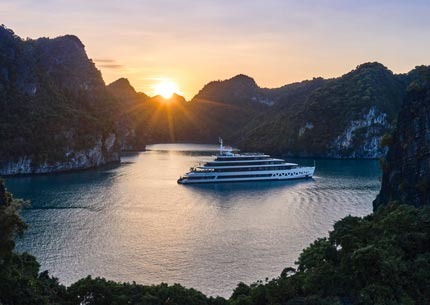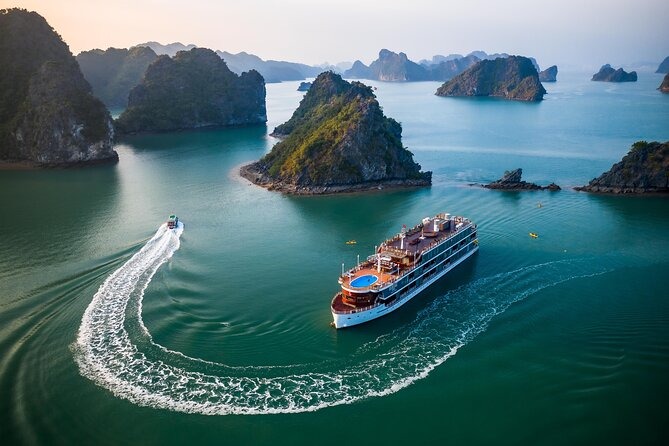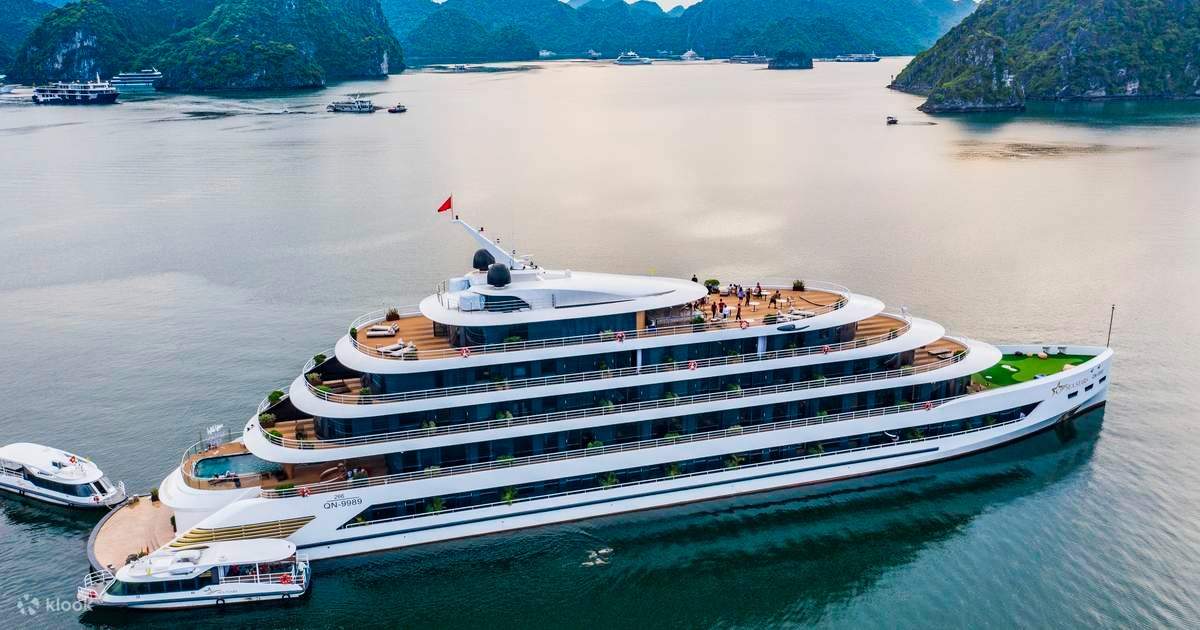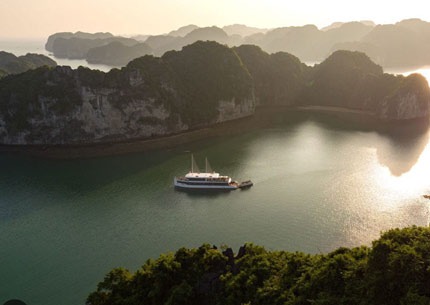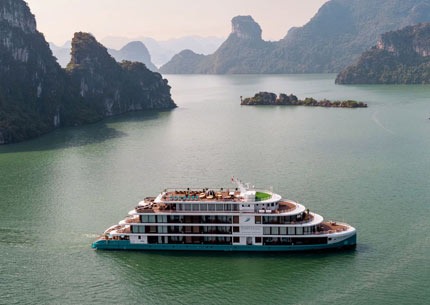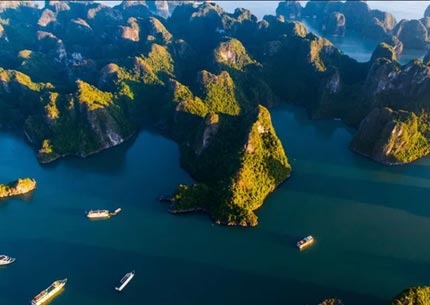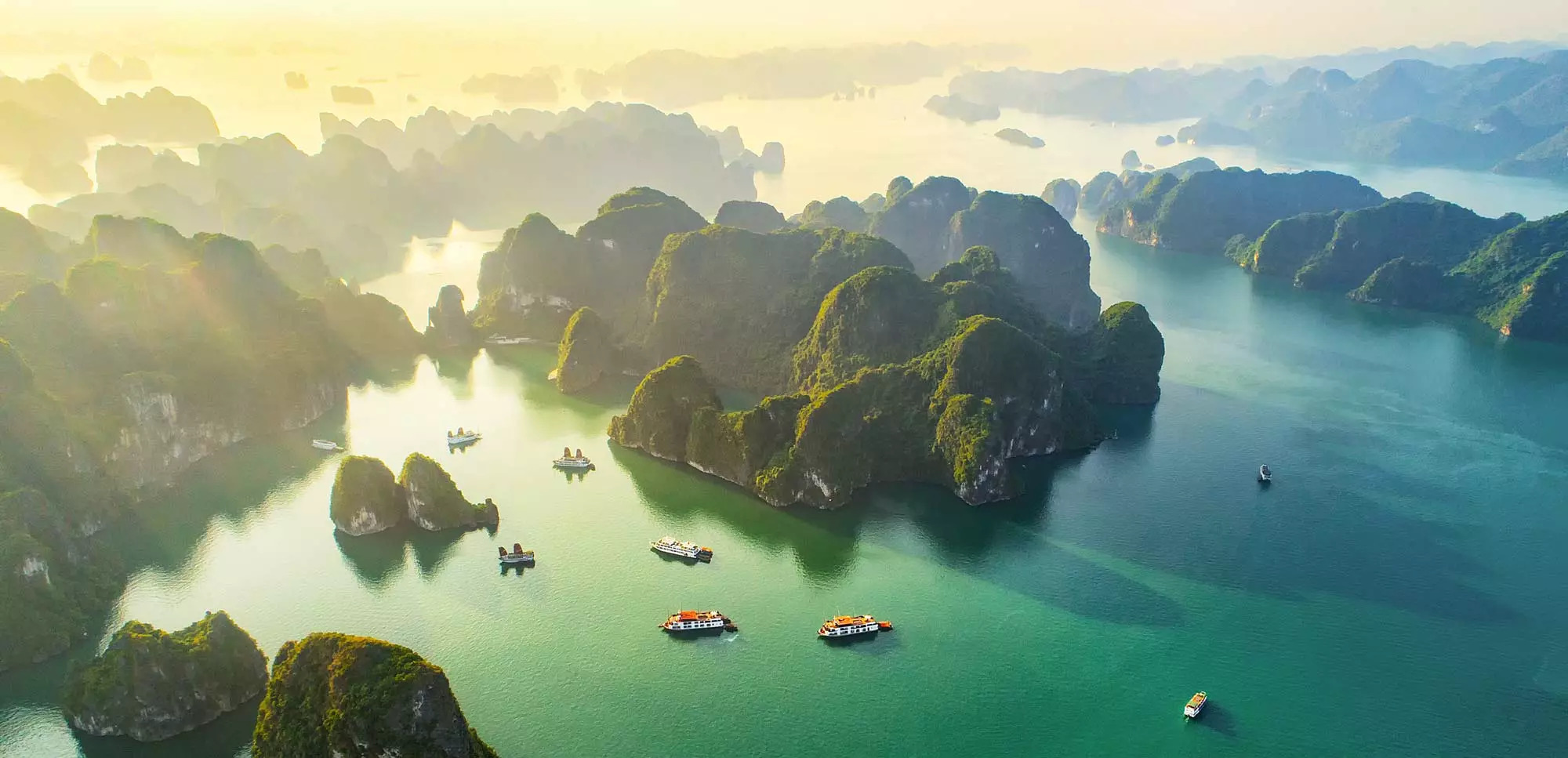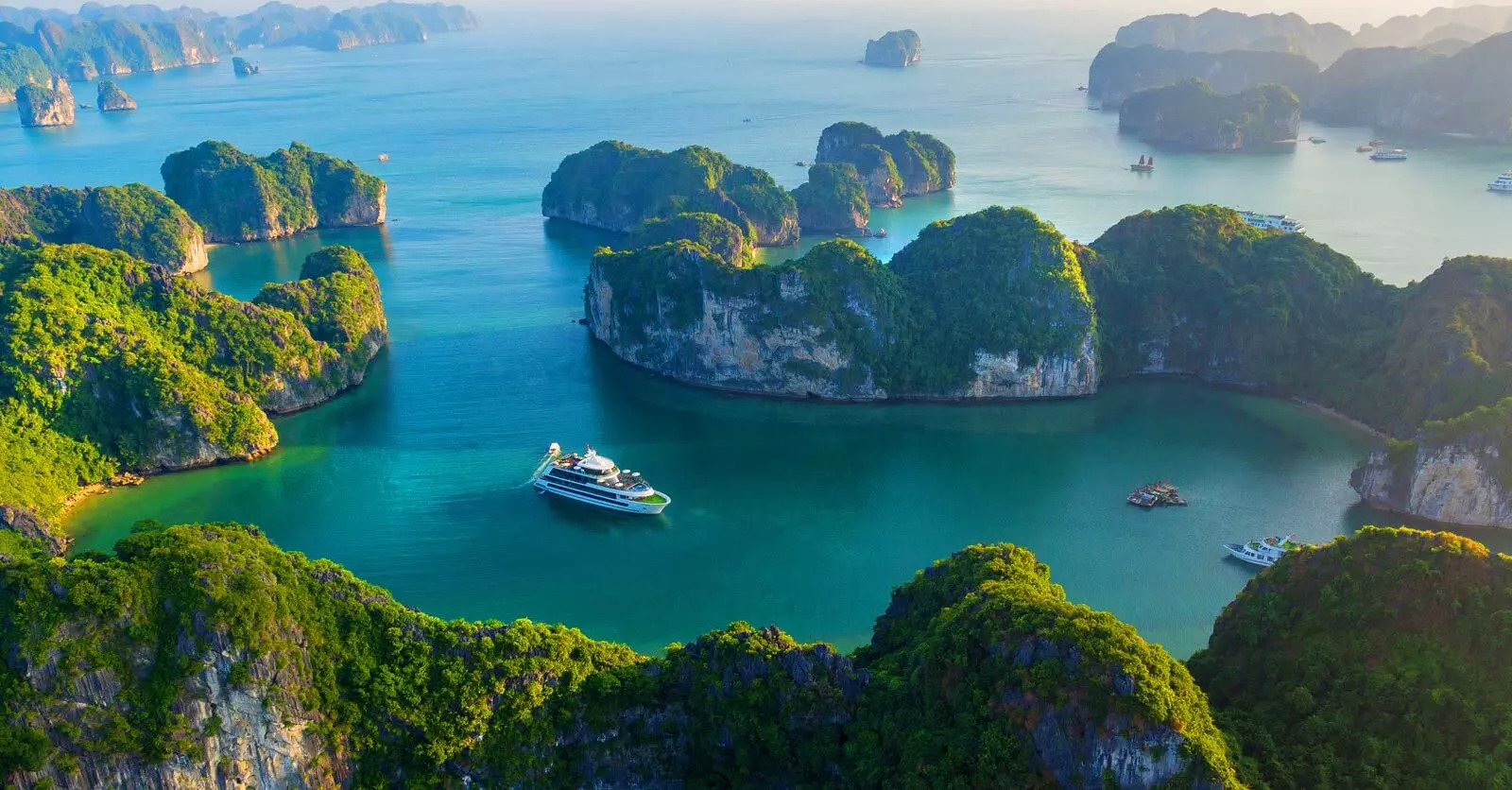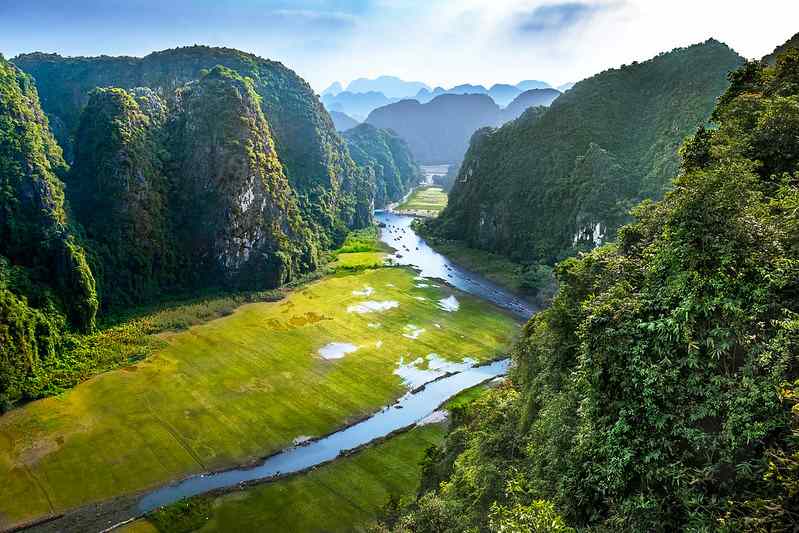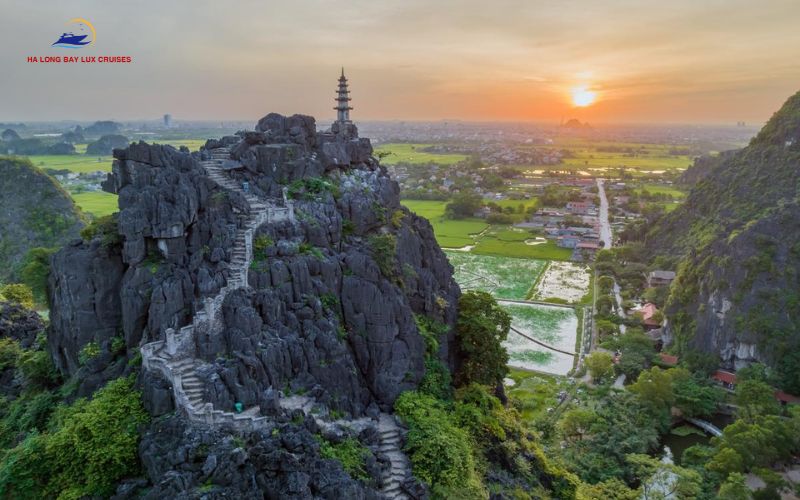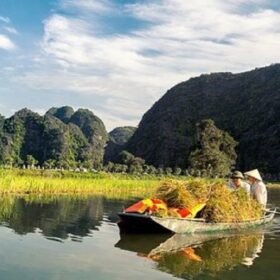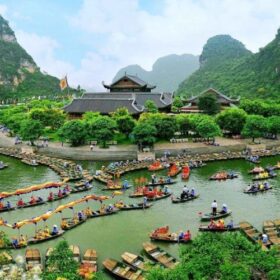15 Best Times to Visit Mua Cave Ninh Binh in 2025-2026: Ultimate Seasonal Guide
Looking for that perfect moment to experience the breathtaking panorama from Mua Cave’s summit? Our comprehensive 2025 guide reveals exactly when to visit for ideal weather, stunning photography opportunities, and a crowd-free adventure in Vietnam’s hidden gem.
The Magical Allure of Mua Cave: An Introduction
Perched in the heart of Ninh Binh Province, Mua Cave (Hang Múa) has transformed from a hidden local secret to one of Vietnam’s most captivating natural attractions. The site’s primary draw isn’t actually the cave itself, but rather the impressive 500-step limestone stairway that winds up Dragon Mountain, rewarding climbers with a 360-degree panoramic view that seems plucked from a fantasy novel.
From this elevated vantage point, visitors can marvel at the sprawling patchwork of emerald rice paddies, winding rivers, and dramatic karst formations that have earned Ninh Binh its nickname as “Halong Bay on Land.” The summit is adorned with a stone dragon sculpture and a goddess statue, adding cultural significance to the natural splendor.
Planning your 2025 visit to Mua Cave requires careful consideration of seasonal variations, as each time of year offers a distinctly different experience. Before embarking on your journey to this breathtaking destination, you might want to consider extending your northern Vietnam adventure with a luxurious Halong Bay cruise to experience the full spectrum of Vietnam’s natural wonders.
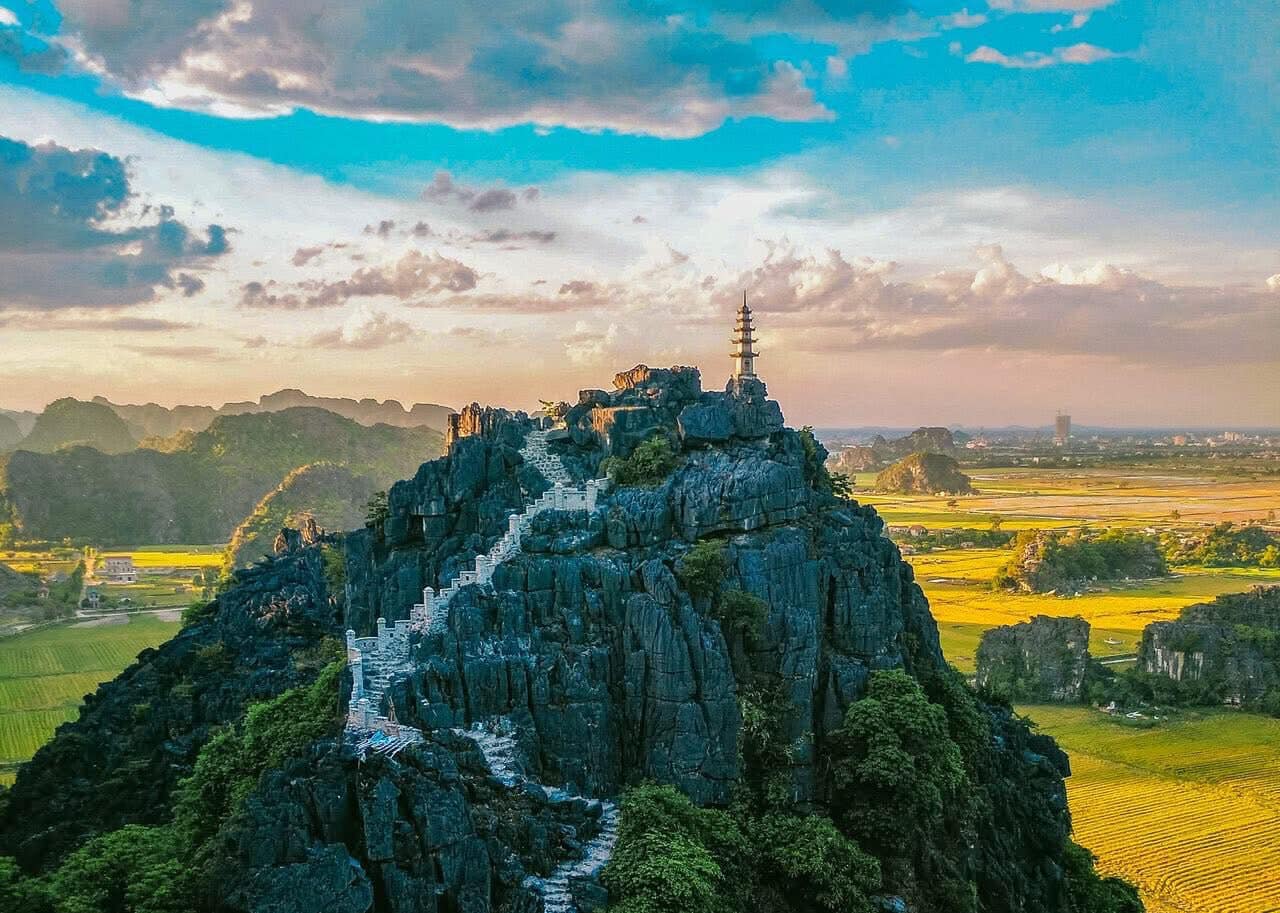
Understanding Ninh Binh’s Climate: The Foundation for Perfect Timing
Ninh Binh experiences a subtropical climate with four distinct seasons, each painting Mua Cave’s surroundings in different colors and atmospheres. Before diving into specific timeframes, let’s understand the climate patterns that will influence your 2025 visit:
- Average Temperature Range: 16°C (61°F) in winter to 35°C (95°F) in summer
- Rainy Season: May to September (heaviest in July and August)
- Dry Season: October to April
- Humidity Levels: Highest from June to August (can reach 85-90%)
- Annual Rainfall: Approximately 1,800mm, with 75% falling during the rainy season
This climate variation creates dramatically different experiences throughout the year, affecting everything from photography conditions to climbing comfort and crowd levels.
Spring Glory: March to May
March : Early Spring Awakening
March marks the beginning of spring in Ninh Binh, bringing with it a refreshing transformation of the landscape. The average temperatures hover pleasantly between 20°C and 25°C (68°F-77°F), creating ideal conditions for the physically demanding climb to Mua Cave’s summit.
What makes March 2025 particularly appealing is the emergence of vibrant greenery across the rice fields below. The paddies, recently planted, begin to carpet the valley in various shades of emerald, creating a stunning contrast against the limestone mountains. Morning mist is common during this month, adding a mystical quality to early visits.
Visitor Insight: March weekdays see approximately 40% fewer visitors than weekend days, making Tuesday through Thursday ideal for a tranquil experience.
April : Peak Spring Beauty
April delivers the quintessential spring experience at Mua Cave with comfortable temperatures averaging 23°C to 28°C (73°F-82°F). The humidity remains moderate at around 70%, providing comfortable conditions for the climb without excessive sweating.
This month offers some of the clearest skies of the year, with an average of 20 clear days, making it exceptional for photography. The landscape reaches its spring peak, with fully grown young rice plants creating a lush green carpet across the valley floor.
Photographer’s Tip: April 10-20, 2025, should offer ideal light conditions with the sun positioned perfectly for capturing both morning and afternoon golden hour shots from the summit.
May : Transition to Early Summer
As May progresses, temperatures begin their climb toward summer levels, ranging from 25°C to 32°C (77°F-90°F). The month starts relatively dry but often transitions to occasional afternoon showers by month’s end, signaling the approaching rainy season.
May offers a unique advantage: the rice fields display their most vibrant green just before the summer harvest begins. The increasing humidity (75-80%) creates atmospheric conditions where distant mountains appear layered in morning light – a photographer’s dream.
Crowd Forecast: According to local tourism data, the first half of May typically sees 30% fewer visitors than April, making it an excellent time for those seeking a balance of good weather and smaller crowds.
Summer Splendor: June to August
June: Golden Harvest Panoramas
June brings the early summer heat, with temperatures regularly reaching 30°C to 34°C (86°F-93°F). While humidity levels climb to around 80-85%, morning and evening hours remain comfortable for the ascent to Mua Cave’s summit.
What makes June 2025 extraordinary is the golden transformation of rice fields as farmers prepare for the first harvest. This creates a spectacular golden-yellow carpet across the valley, completely different from the green panoramas of spring. Early June also experiences fewer rainfall days than July and August, with precipitation typically limited to late afternoon showers.
Seasonal Highlight: The first harvest season begins in early June, allowing visitors to witness traditional farming methods in action throughout the valley below.
July : Lush Green Revival
July represents the heart of summer in Ninh Binh, bringing consistent temperatures between 32°C and 35°C (90°F-95°F) with humidity levels reaching their yearly peak at 85-90%. While these conditions make midday climbing challenging, they also ensure you’ll find far fewer tourists.
After the June harvest, farmers quickly replant the fields, and by mid-July, the landscape transforms again into a fresh green patchwork. July also delivers dramatic skies with afternoon thunderstorms creating spectacular cloud formations – perfect for photographers willing to work around the weather.
Travel Strategy: Plan your July 2025 visit for weekday mornings (before 9:00 AM) to avoid both the afternoon heat and potential rainfall. Bring moisture-wicking clothing and plenty of water for the climb.
August : Dramatic Skies and Verdant Views
August continues the summer weather pattern with temperatures averaging 30°C to 34°C (86°F-93°F) and frequent afternoon rainfall. This month typically records the highest precipitation of the year in Ninh Binh, with an average of 18 rainy days.
However, August 2025 offers a compelling advantage for photographers and nature lovers: the landscape reaches peak lushness, with vegetation at its most vibrant. The mountain slopes around Mua Cave turn intensely green, and water features throughout the valley appear full and dynamic.
Weather Insight: According to climate predictions for 2025, August 15-25 may offer a brief respite from heavy rains, potentially providing a window of clearer weather during this typically wet month.
Autumn Perfection: September to November
September: The Photographer’s Dream Month
September marks the beginning of autumn in Ninh Binh and is widely considered the single best month to visit Mua Cave. Temperatures moderate to a comfortable 26°C to 32°C (79°F-90°F), and humidity begins its gradual decline. Rainfall becomes less frequent and more predictable, typically occurring as brief afternoon showers.
What makes September 2025 extraordinary is the second rice harvest, transforming the valley into a golden sea. This golden period, combined with the clearer autumn air and dramatic cloud formations, creates perfect conditions for photography. The morning light in particular casts a magical glow across the ripening rice fields.
Visitor Experience: September weekday mornings offer the most serene experience, with visitor numbers approximately 45% lower than during peak season weekends.
October: Clear Skies and Comfortable Climbing
October delivers what many consider the most pleasant weather conditions of the year at Mua Cave. With temperatures ranging from 23°C to 28°C (73°F-82°F) and significantly reduced humidity (60-65%), the 500-step climb becomes much more comfortable.
The month is characterized by consistently clear blue skies with excellent visibility, allowing visitors to see the furthest distances from the summit. By mid-October, the post-harvest fields begin showing patches of green again as winter crops are planted, creating an interesting patchwork effect across the valley.
Photography Tip: October clear conditions make it ideal for sunset photography from the summit, with golden hour typically occurring around 5:30 PM early in the month.
November 2025: Atmospheric Misty Mornings
November introduces early winter characteristics to Ninh Binh, with temperatures cooling to 19°C to 25°C (66°F-77°F). The month brings the lowest humidity of the year (averaging 55-60%) and minimal rainfall, creating ideal hiking conditions.
What makes November 2025 special is the emergence of morning mist that often blankets the valley until mid-morning. This creates ethereal scenes where only the peaks of karst mountains emerge from a sea of clouds – a photographer’s dream scenario that’s relatively rare during other months.
Seasonal Appeal: By November, tourist numbers drop significantly (approximately 60% lower than peak season), providing a much more peaceful experience at the summit.
Winter Tranquility: December to February
December: Serene Holiday Season
December brings cooler temperatures to Mua Cave, ranging from 16°C to 22°C (61°F-72°F). The weather is typically dry with clear skies, though the morning air can feel quite crisp at the summit, requiring light layering for comfort.
What makes December 2025 appealing is the remarkable clarity of light. The winter sun casts longer shadows and creates more dramatic contrasts across the landscape. The winter crops in the fields below create patches of green amid the predominantly brown winter palette.
Holiday Note: Despite December being a major holiday month globally, Mua Cave sees relatively low international tourism during this period, making it an excellent time for a peaceful visit.
January 2026: Misty Mountain Magic
January presents the coolest month in Ninh Binh, with temperatures ranging from 14°C to 20°C (57°F-68°F). Morning temperatures can occasionally dip lower, especially at the exposed summit of Mua Cave. The month is predominantly dry, with rainfall rarely disrupting visitors’ plans.
The standout characteristic of January is the frequent morning mist that creates dreamlike scenery. This phenomenon, combined with the low winter sun angle, produces dramatic lighting effects as sunbeams cut through the mist and illuminate portions of the landscape below.
Cultural Insight: January 2026 leads into the Lunar New Year period (Tết), which falls in early February. The weeks before Tết showcase interesting agricultural activities as farmers prepare for the holiday season.
February 2026: Spring Festival Energy
February bridges winter and spring, with temperatures gradually warming to 15°C to 22°C (59°F-72°F) by month’s end. The air remains relatively dry, and skies are typically clear, offering excellent visibility from the summit.
February 2026 will be particularly significant as it marks the Lunar New Year (Tết) celebrations in Vietnam. While this means domestic tourism increases dramatically around the holiday period (February 1-7, 2026), it also offers visitors the chance to experience traditional celebrations, decorations, and cultural activities throughout Ninh Binh province.
Travel Strategy: Visit during mid-to-late February to experience the post-Tết atmosphere while avoiding the major holiday crowds. The landscape begins showing early signs of spring renewal during this period.
Optimal Times of Day for Your Mua Cave Visit
Sunrise Magic: 5:30 AM – 7:30 AM
The early morning hours offer several distinct advantages for your Mua Cave experience:
- Cooler Temperatures: Even in summer months, morning temperatures can be 5-10°C lower than midday
- Dramatic Lighting: The rising sun creates long shadows and golden light across the landscape
- Morning Mist: Particularly from November through March, morning mist creates ethereal scenes
- Fewer Crowds: Before 8:00 AM, you’ll often have the summit largely to yourself
2025 Sunrise Times: Summer (approximately 5:30 AM), Winter (approximately 6:30 AM)
Golden Hour Glory: 4:30 PM – 6:30 PM
Late afternoon visits provide a completely different but equally rewarding experience:
- Warm Golden Light: The setting sun bathes the landscape in rich, warm tones
- Cooler Temperatures: After the midday heat dissipates, especially welcome in summer
- Dramatic Cloud Formations: Particularly during summer months, afternoon clouds create dynamic skies
- Moderate Crowds: Many tour groups depart by 4:00 PM, creating a less crowded experience
2025 Sunset Times: Summer (approximately 6:30 PM), Winter (approximately 5:30 PM)
Insider Tips for Avoiding Crowds at Mua Cave
Planning your visit strategically can dramatically improve your experience at this increasingly popular destination:
- Weekday Advantage: Tuesday and Wednesday consistently show 35-40% lower visitor numbers than weekend days throughout 2025
- Early Bird Rewards: Arriving at opening time (7:00 AM) puts you ahead of approximately 90% of daily visitors
- Lunchtime Window: Between 12:00 PM and 1:30 PM, many tour groups break for lunch, creating a brief period of lower activity
- Weather-Based Strategies: Light rain forecasts often deter casual tourists but can create spectacular atmospheric conditions for photography
- Monthly Insights: According to visitor projection data for 2025, the lowest overall visitor numbers are expected during:
- Last two weeks of January 2026 (post-holiday, pre-Tết period)
- First two weeks of November 2025 (shoulder season transition)
- Mid-July 2025 (peak of hot season when many tourists avoid outdoor activities)
Cultural Festivals and Special Events Near Mua Cave
Aligning your visit with local cultural events can add a meaningful dimension to your Mua Cave experience:
Bai Dinh Pagoda Festival (February)
Located just 15 kilometers from Mua Cave, this major Buddhist festival features traditional ceremonies, folk performances, and pilgrimage activities. The festivities typically last through the first two weeks of the lunar new year.
Trang An Tourism Week (May)
This annual celebration showcases Ninh Binh’s cultural heritage through traditional music performances, craft exhibitions, and special boat tours throughout the Trang An landscape complex. Special evening events illuminate the karst landscape.
Hoa Lu Ancient Capital Festival (April)
Commemorating King Dinh Tien Hoang, this festival takes place at the ancient capital of Hoa Lu, just 10 kilometers from Mua Cave. Highlights include a solemn procession, traditional games, and folk performances that bring ancient Vietnamese culture to life.
Rice Harvest Festivals (Early June and late September)
While not formal events, these harvest periods offer visitors the chance to witness and even participate in traditional farming activities. Local homestays often organize special meals and demonstrations during these culturally significant times.
Cultural Tip: Combining your Mua Cave visit with one of these festivals allows you to experience both the natural and cultural heritage of Ninh Binh. Consider extending your northern Vietnam adventure to fully immerse yourself in the region’s offerings.
Photography Guide: Capturing Mua Cave’s Magic in
For photography enthusiasts, timing can make the difference between a good photo and an extraordinary one:
Best Seasonal Light for Photography
- Spring (March-May): Clear mornings with vibrant green landscapes; dramatic afternoon clouds
- Summer (June-August): Intense golden hours; dramatic storm clouds; lush vegetation
- Autumn (September-November): Clearest atmospheric conditions; golden harvests; longest golden hour periods
- Winter (December-February): Low-angle sunlight creating pronounced textures; morning mist; clear blue skies
Technical Photography Tips for Mua Cave
- Wide-Angle Essential: Bring a lens in the 16-24mm range to capture the expansive panoramic views
- Polarizing Filter: Helps manage glare and enhance the vibrant colors of the landscape
- Tripod Considerations: While useful for low-light situations, note that tripods may be restricted during peak visitor hours
- Drone Regulations: As of 2025, drone photography requires advance permission from local authorities
- Recommended Viewpoints:
- The Dragon’s Spine (highest point) for 360° panoramas
- The eastern viewing platform for morning light
- The western steps for dramatic stair compositions
Professional Insight: “September 15-25, 2025, offers the perfect combination of golden rice fields, clear air, and moderate tourist numbers—ideal for serious landscape photographers.” — Vietnam Photography Association forecast
Beyond Mua Cave: Creating the Perfect Ninh Binh Itinerary
Maximize your visit by exploring these complementary attractions near Mua Cave:
Morning: Mua Cave Summit Adventure
Start your day with an early climb to catch the magical morning light at Mua Cave’s summit. The 500 steps take approximately 20-30 minutes to ascend, depending on your fitness level. Allow at least an hour at the top to fully appreciate the panoramic views and capture photographs.
Midday: Trang An Boat Tour
After descending from Mua Cave, head to the UNESCO-listed Trang An Scenic Landscape Complex for a traditional sampan boat tour. These 2-3 hour journeys navigate through karst mountains via caves and waterways, offering a different perspective of Ninh Binh’s landscape. The boat routes were expanded for 2025 to include new cave systems.
Afternoon: Bich Dong Pagoda
Just 3 kilometers from Mua Cave lies the three-tiered Bich Dong Pagoda, built into the limestone mountainside. Dating back to 1428, this atmospheric temple complex offers a serene cultural experience with significantly fewer visitors than other attractions in the area.
Evening: Tam Coc Sunset Viewing
Complete your day with a sunset view over the Tam Coc rice fields, where the evening light transforms the landscape into a golden paradise. Several new viewing platforms were completed in 2024, offering perfect vantage points without requiring strenuous climbing.
Extended Adventure: For travelers seeking to experience the full spectrum of northern Vietnam’s natural wonders, consider combining your Ninh Binh experience with a luxury cruise through Halong and Lan Ha Bay. The limestone formations of Halong Bay offer a fascinating comparison to those of Ninh Binh, showcasing how similar geological processes created two distinctly different landscapes.
Final Thoughts: Choosing Your Perfect Time for Mua Cave
Mua Cave offers a remarkable experience throughout the year, with each season painting its unique character across the landscape. Your ideal visiting time depends on your personal priorities:
- For Photography: September and October offer the most photogenic conditions, with golden rice fields, clear skies, and comfortable temperatures.
- For Comfortable Hiking: April, May, October, and November 5 provide the most pleasant climbing conditions with moderate temperatures and lower humidity.
- For Avoiding Crowds: January, early February, and mid-July present the lowest visitor numbers, offering a more serene experience.
- For Cultural Immersion: Aligning your visit with local festivals in February, April, or May enriches your experience beyond the natural landscape.
Whatever time you choose to visit , Mua Cave stands as a testament to Vietnam’s extraordinary natural beauty. The 500 steps may challenge your legs, but the reward—a breathtaking panorama that stretches across one of Vietnam’s most picturesque landscapes—creates memories that will last a lifetime.
Remember that the journey through Vietnam’s northern wonders doesn’t need to end in Ninh Binh. Many travelers continue their adventure with a luxury cruise experience in Halong Bay, creating the perfect balance of mountain and maritime landscapes in a single unforgettable journey.
- Hotline | WhatsApp: +84.978.358.422
- Phone | WhatsApp: +84.962.261.687
- Email: halongbayluxcruises@gmail.com
- vietnammarveltravel@gmail.com

